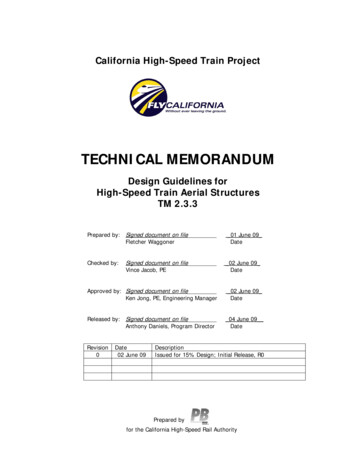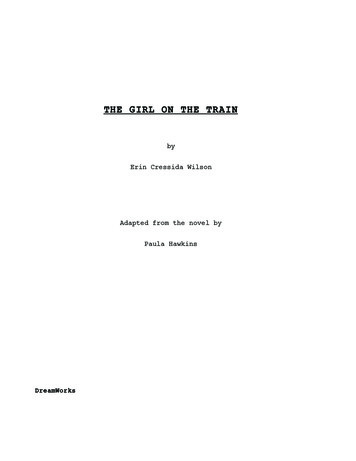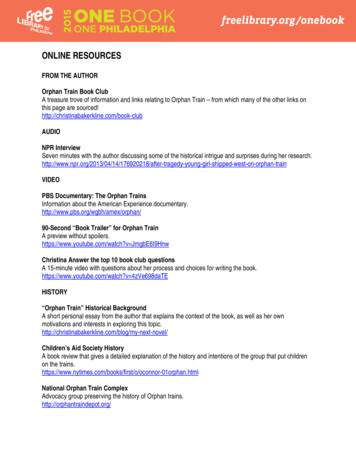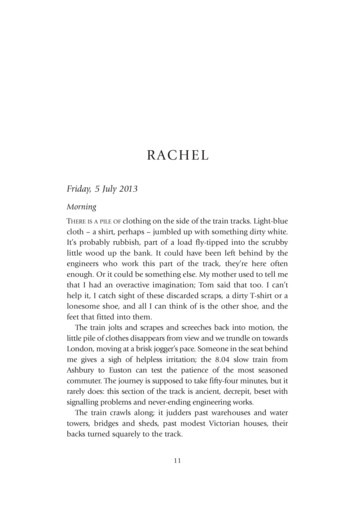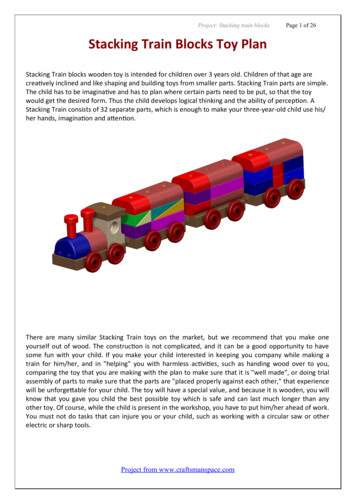
Transcription
The Asia-Pacific Journal Japan FocusVolume 13 Issue 26 Number 4 Article ID 4336 Jun 29, 2015Surviving the Last Train From Hiroshima: The Poignant Caseof a Double Hibakusha 広島からの終電を生き抜いて 二重被爆者の心打つ物語Charles PellegrinoThe original title of my proposed book aboutHiroshima and Nagasaki was, “The Last Trainto Nagasaki.” I believed the title conveyed howI would bridge the story of the two cities via thepeople who had survived both atomic bombings– the double hibakusha. In this manner, Ithought I could correct the problem of howhistory all but forgot the second and even morepowerful atomic bomb and its victims. As onesurvivor expressed the forgetting: “It is nevergood to be the second of anything.” I did notknow how extreme the forgetfulness hadbecome. In 2009, my editor discovered thatalmost no one at the publishing house knewwhat the name, Nagasaki, referred to – andthus the title change, to a name familiar toeveryone: “The Last Train from Hiroshima.”where we designed nuclear melt-throughprobes for exploration of new oceans turningup beneath the ice of Jupiter’s moon Europa –in addition to a Valkyrie rocket that couldactually bridge the rest of the Solar System,and perhaps even interstellar space. Along theway, I met survivors of the atomic bombs, andbegan recording their stories. In 2001, I wasworking on forensic physics/archaeology in theruins of the World Trade Center. In a landscapepossibly even grayer than the surface of themoon, thousands of bundles of paper craneswere arriving, becoming the only splashes ofcolor and beauty. I met the Ito and Sasakifamilies when they visited, and I learned fromthem the word Omoiyari – which may berendered as empathy (translated, in America,as the “pay-it-forward” principle)–I learned it asa way of life, and not just a word.Approximately 300 people are known to havemade the journey, aboard two trains, fromHiroshima all the way to Nagasaki in the wakeof the atomic bombing of August 6, 1945. Ofthis group, approximately 90% were killed bythe second atomic bomb. In “Last Train,” thedouble hibakusha bracket and interweave withthe stories of other survivors, ranging fromconscripted schoolchildren and doctors atNagasaki to the origin of the thousands ofpaper cranes that were sent from the childrenof Hiroshima to the children of New York in2001.In the New York death-scape, whereexpressions about “nuking” someone rolled tooeasily off people’s tongues, it occurred to methat almost no one really knew what the words“nuke-them” meant. Most seemed to regard theatomic bomb as an antiseptic weapon thatinstantly erased “the bad guys” and allowedthose outside the target area to somehow justwalk away. After I added new hibakushainterviews to my archive, and showed chaptersto colleagues, the most important review Ireceived (or probably ever will receive), camefrom archaeologist Amnon Rosenfeld – who hadbeen very hawkish and believed in pre-emptivenuclear strike. After reading the draft, he saidthat everything he thought he knew about whathappened in Hiroshima and Nagasaki wasAs a child of the “Duck and Cover” drills, Igrew up to eventually embrace what I fearedmost (the very physics that made possible, thethermonuclear inverse to the Golden Rule).During the 1980s, I joined brainstormingsessions at Brookhaven National Laboratory,1
13 26 4APJ JFprevented book burnings (as threatened inemails from “veterans”), by withdrawing thefirst edition and pulping it. In the real world,you will be hard-pressed to find an Americanveteran who endorses censorship. No less anauthority on such matters than Tom Dettweiler(who survived the destruction of the Pentagon’sNavy wing on 9/11 on account of having beencalled away for an eye exam), observed:“Despite past attempts to suppress this history,Charles has succeeded in a detailedimmortalization of one of the true turningpoints in human existence [It] should berequired reading for all those making decisionsof war.”wrong, adding that anyone who learns thetruth, and who designs nuclear weapons orplans first use for any reason whatsoever, “hasfound the unforgivable sin.”My hope is that others will come to theRosenfeld conclusion. My hope is that thisglimpse of the past (through the science ofwhat happened, combined with the humanperspective), will in at least some small wayhelp to prevent the hibakusha experience frombecoming prophecy for much of our worldduring the next thirty years. My hope is thatnuclear war will have ended, forever, at theblack granite pinnacle marking the hypocenterof Nagasaki.The ultimate accomplishment of 2010’s internethoaxers and impersonators was to bring manynew truths to light. Chief among these was thecoming forth of survivors who had hidden theirexperiences, and who had intended to taketheir stories to the grave. For most, speaking ofit was very difficult, often a very painfulexperience. I cannot thank them more, for theirbravery.After the first American edition of “The LastTrain from Hiroshima” was published in 2010, Ilearned that one of the Tinian Island aviators Iinterviewed had exaggerated part of his warrecord, and I announced my mistake and theneed for a correction from New York, on theJohn Batchelor Show. This seemed to haveopened the floodgates for e-mailers denying theexistence of “shadow people” and otherthermal effects near the hypocenters, alongwith denial of radiation effects. The e-mailwrecking crew managed to spoof the NY Timesand my publisher by pretending to be everyonefrom famed Hiroshima artist and hibakushaKeiji Nakazawa to veterans threatening masspublic burnings of the book.Among these, in the new edition (To Hell andBack: The Last Train from Hiroshima, ima,August 6, 2015), are four new and morecomplete accounts from the double hibakusha.I first heard about the double atomic bombsurvivors from the father of a friend, who wastrying to learn what happened to Kenshi Hirataand who (despite his background in the FederalBureau of Investigation), died before findingany clues as to where the Hirata family hadgone into hiding after 1957. Kenshi Hirata isone of the people who came forth after the2010 controversy, and what has emerged is oneof the most touching and improbable lovestories in all of human experience.The real Keiji Nakazawa was in fact on my sideand took special interest in my attempts tolearn more about the atomic orphans. Hehelped me and Steve Leeper (then Director ofthe Hiroshima Peace Cultural Foundation) tofill in a blank space in our history (theorphans). With Nakazawa’s input, the atomicorphans can finally speak loud and clear- afterseven decades. Real veterans of the 509th nevermade threats to my publisher about pickets andbook-burnings, and in fact veterans and theirfamilies contributed details to the new edition.Nonetheless, the publisher had by thenWe now have, finally, the rest of KenshiHirata’s story. I have excerpted and adapted2
13 26 4APJ JFinteractions with the world were so weak as tobe utterly ghostly. Almost every one of themthat encountered Setsuko continued throughthe floor without noticing her, then traveledwith the same quantum indifference throughthe Earth itself. The very same neutrinos thatpassed through Setsuko, drawing a straightline between her and the bomb, and throughnearly 5,000 miles of rock, emerged throughthe floor of the southern Indian Ocean andsprayed up toward interstellar space. Setsuko’sneutrino stream would still be traveling beyondthe stars of Centaurus, beyond the far rim ofthe galaxy itself – still telling her story (as itwere), long after the tallest skyscrapers andthe Pyramids had turned to lime.the Hirata history below from the severalchapters through which this family’s story arcweaves – including information about what washappening around him, to provide the contextof time and place.When Setsuko’s neutrino spray erupted unseen,near the French islands of Amsterdam and St.Paul, not quite 22 milliseconds afterdetonation, she was still alive.1 Ceramic rooftiles, three meters above her head, were justthen beginning to catch the infra-red maximumfrom the flash—which peaked 150 millisecondsafter the first atoms of uranium-235 began tocome apart. The tiles threw a small fraction ofthe rays back into the sky, but in the end, theyprovided Setsuko with barely more protectionthan the silk nightgown her beloved Kenshi hadbought her only a few days earlier during theirhoneymoon at the Gardens of Miyajima.[Kenshi Hirata [Illustration: CP]AT A QUARTER-PAST eight on August 6, 1945,near the center of a pomegranate’s volume ofcompressing uranium, the vast majority of thebomb’s energy had radiated from a sparkscarcely wider than the tip of young SetsukoHirata’s index finger. By the time the goldenwhite plasma sphere had spread eighty meterswide—still within only one small part of alightning bolt’s life span—the spark hadgenerated a short-lived but very intensemagnetic field, from which streamers of ironand tungsten nuclei were shot-gunned towardthe ground and toward the stars, at up to 90percent light speed.Overhead, along the lower hemisphere of theblue-to-gold to blue-again globe that expandedfrom the place where the bomb had been, theinstantaneous transformation of matter intoenergy had produced a light so intense that ifSetsuko were looking straight up, she wouldhave seen the hemisphere shining through thesingle layer of roof tiles and wooden planks asif it were an electric torch shining through thebones of her fingers in a darkened room. Andwithin those first two-tenths of a second, shemight have had time enough to become awareof an electronic buzzing in her ears, and atingling sensation throughout her bones, and afeeling that she was being lifted out of herSetsuko Hirata was seated in her living room,slightly to the south and almost directlybeneath the magnetic shotgun. Acceleratedfragments of atomic nuclei came down throughtiles and roof beams and either stopped insideher body or kept going until stopped by thefirst hundred meters of sand and bedrock.Neutrinos also descended through the roof.Born of the so-called weak force, their3
13 26 4APJ JFchair, or pressed into it more firmly, or both atthe same instant—and the growing sphere inthe sky she might even have had time enoughto perceive, if not actually watch, its expandingdimensions.sending forth a blast wave that was all butfractionally spent by the time it reached him.Kenshi’s next instinct did not serve him so wellas his obedience to the voice. When he droppedto the floor, his initial impression was that anumber of huge incendiary bombs wereexploding right on top of the building and thathe would be cremated even before he couldfinish the first lines of a prayer. But nearly fivefull seconds followed the flash, and the lightitself began to fade without a hint ofconcussion—The bombs have not struck thebuilding—Setsuko’s husband, Kenshi, had been workingas an accountant at the Mitsubishi WeaponsPlant, slightly more than four kilometers away,when through a window came the mostbeautiful golden lightning flash he had everseen, or imagined he would ever see.Simultaneously there was a strange buzzing inhis ears, a sizzling sound, and a woman’s voicecrying out in his brain. He would suppose yearslater that maybe it was his grandmother’sspirit—or more likely Setsuko’s. The voicecried, “Get under cover!”The multiple bombing-raid escapee raised hishead to see what was happening around him. Ayoung woman nearby had crept to a windowand peeked outside. Whatever she saw in thedirection of the city, Kenshi would never know.She stood up, uttered something guttural andincomprehensible, and then the blastwave—lagging far behind the bomb’s lightwaves—caught up with her. By the time thewindowpanes traveled a half-meter, they hadseparated completely from their protectivecross-hatched net of air-raid tape, emerging asthousands of tiny shards. Like the individualpellets of a shotgun blast, each shard had beenaccelerated to more than half the speed ofsound. The girl at the window took at least aquarter-kilogram of glass in her face and herchest before the wind jetted her toward the farwall.With all the speed of instinctive reflex, hedropped the papers he was carrying, dove tothe floor, and buried his face in his arms. Butthree long seconds later when the expectedshockwave had not arrived, he was left inadrenalized overdrive—with time to pray.Outside his Mitsubishi office, in utter silence, agiant red flower billowed over the city, risingon a stem of yellow-white dust.Kenshi’s prayers seemed to have beenanswered—yet again. He had walked awayfrom the fire-bombing of Kobe on March 16-17,1945 without a single blister or bruise, initiallythinking himself a bit unlucky because heshould never have been there in the first place;and Kenshi would never have been there, hadhe not finished his work in Osaka a day earlyand departed for Kobe ahead of schedule. Twonights after surviving Kobe, he learned thatOsaka, too, had been heavily bombed. Indeedthe very same hotel in which he should havebeen sleeping took a direct hit, with nosurvivors. At Hiroshima, Kenshi owed hissurvival to an instinct to obey an inner voice,and to the fact that the bomb had disappointedits creators, performing at only about half itsintended yield (up to 12.5 kilotons), andKenshi did not see where she eventuallylanded. Simultaneous with the window blast,the very floor of the building had come off itsfoundation and bucked him more than a halfmeter into the air. He landed on his back, andwhen he stood up he discovered to his reliefthat he was completely unharmed, thendiscovered, to his horror, that he was the onlyone so spared. All of his fellow workers—all ofthem—looked as if they had crawled out of ablood pool.We must have taken a direct hit after all,4
13 26 4APJ JFKenshi guessed. He did not realize the fullmagnitude of the attack until he steppedoutside. In the distance, toward home, the headof the flower was no longer silent. It had beenrumbling up there in the heavens for more thana minute, at least seven or ten kilometers highnow, and it had dulled from brilliant red todirty brown, almost to black. As he watched,the flower broke free from its stem and asmaller black bud bloomed in its place. It was,a fellow survivor would recall, like adecapitated dragon growing a new head.hypocenter, not very far from the city’sMunicipal Office, he passed over a warm roadsurface upon which a great fire must haverisen, then inexplicably died. All of the peoplesimply disappeared here, and all of the woodenhouses, on either side of the road, werereduced to grayish-white ash. He thought ofSetsuko. The main street leading toward homeand Hiroshima’s famous “T”-shaped bridgeseemed more like a field than a road. In themiddle of the field, he found two blackenedstreetcars. Their ceilings and windows hadvanished and they were filled with lumps ofcharcoal that turned out to be passengerscarbonized in their seats. The trolleys hadapparently stopped on either side of the streetto pick up more passengers, and two peoplewere about to ascend the steps of one vehiclewhen the heat descended, and caught them,converting them into bales of coal with shirtbuttons and teeth. In every direction, Kenshisaw pieces of people, and horses, and oxen,looking like charcoal. He thought of Setsuko,now blaming himself for their ill-omenedhoneymoon excursion, nearly two weeksearlier, to the Shrine Island of Miyajima.A whisper escaped Kenshi’s lips: “Setsuko ”2#KENSHI MADE HIS WAY toward the center ofthe city. He had no choice. His wife was inthere, somewhere beneath the dragon’s head.Within perhaps a thousand meters of the placehe believed to be home, the streets and fieldssprouted what seemed to be thousands of tinyflickering lamps. He could not determine whatthe lamps might actually be. Neither could anyof the scientists who would hear of this later.Each jet of flame was about the size and shapeof a doughnut. Kenshi knew that he could easilyhave extinguished any “ground candles” in hispath merely by stepping on them; but he was“spooked” by an instinctive sense that it mightsomehow be dangerous to touch the fierydoughnuts, so he stepped around theminstead. 3 He thought of Setsuko. He passedmen and women whose backs had been searedby the flash, but it was not the flash-burns thatcaught his attention and stuck in his memory.The people appeared to be growing strangevegetation out of their roasted flesh. Itoccurred to Kenshi only much later thatthousands of glass slivers must have beenpulled from the windows of every building anddriven through the air like spear points. Hethought of Setsuko. Limping, the youngaccountant circumnavigated a giant column offlame in which steel beams could be seenmelting. He thought of Setsuko. Nearer theThere was a strange taboo in connection withthe Miyajima Shrine. It had been dedicated to agoddess who was believed by the oldergenerations to become jealous if a newlymarried husband and wife climbed the sacredsteps together. If the taboo was violated, theold people said, the wife would shortly die. ButKenshi’s friend, a local innkeeper who hadarranged honeymoon lodgings for them nearthe island’s gardens, had scoffed at this andsaid it was pure superstition. Since they hadcome all the way to Miyajima together, headvised, surely they should go at once to thefamous shrine. So they did. And now, duringthe journey from his office into the heart ofGround Zero, Kenshi repented of it manytimes.4#5
13 26 4APJ JFTHE STREETS OF HIROSHIMA were full ofintriguing, seemingly impossible juxtapositionsbetween the utterly destroyed and themiraculously unharmed. The roof tiles ofKenshi’s home had boiled on one side and werecracked into thousands of tiny chips, andevidently the entire structure wassimultaneously roasted and pounded nearly ahalf-meter into the earth. A few doors away,evidence of a gigantic shock bubble, in whichthe very atmosphere had recoiled at supersonicspeed from the center of the explosion, couldbe seen in the evidence of the bubble’simmediate aftereffect—the “vacuum effect”that had developed behind an outracing shockwave, pulling everything back again towardsthe center, toward the actual formation point ofthe mushroom cloud, almost directly overhead.The force of the imploding shock bubble hadalso pulled air-filled storm sewers up throughthe pavement. These manifestations only hintedat the forces unleashed when the low-densitybubble, its walls shining with the power ofplasma and super-compressed air, had spreadand cooled to a point at which the press inwardby the surrounding atmosphere started tobecome stronger than the heat and shockpushing away from the uranium storm. At thispoint, the shock bubble was only about 250milliseconds old—just a quarter-second pastMoment Zero and 400 meters in radius. Whenthe bubble collapsed, less than two-tenths of asecond later and nearly twenty blocks wide, theupdraft experienced directly below, in Kenshi’sneighborhood, was amplified by the almostsimultaneous rise of the retreating plasma,which behaved somewhat like a superheatedhot-air balloon. As it rose and lost power, it hadcooled from a fireball to an ominous blackflower head, and had begun to shed debris theway a flower sheds pollen. Bicycles, bits ofsidewalk, planks of wood, even half of a grandpiano, fell out of the cloud, more than 800meters away from the hypocenter.5the ground. Kenshi discovered that trees,although dry roasted and stripped of theirleaves, were still standing upright andunbroken in a 30-meter wide area just outsideof his immediate neighborhood. Along otherpoints of the compass, everything either fellapart, or disappeared. Normally, one shouldnot have been able to see the mountains or theweather station’s transmission tower from thislocation because there were rows of buildingsin the way. But whenever the gusts of smokeand dust pulled apart, it was easy to see thatthe obstructions were all gone, now. The citywas flat. The whole thing. Little seemedrecognizable, except broken sewing machines,concrete cisterns, blackened bicycles andstreetcars, and piles of reddish-black flesheverywhere, a few vaguely in the shapes ofhuman figures, or occasionally in the shapes ofhorses.The Mitsubishi accountant would probably haveescaped Hiroshima with no radiation injury atall had he not gone into the center of the blastarea searching for Setsuko. Once he breathedthe dry dust, then cleared the dust from histhroat by drinking brownish-black water from abroken pipe, his cells were absorbing strangenew variations on some very common elements.These new incarnations, or isotopes, tended tobe so unstable that by the time he awoke in themorning most of them would no longer exist.Like little energized batteries, they were givingup their power. Unfortunately, they weredischarging that power directly into Kenshi’sskin and stomach, into his lungs and blood. Thequirk that spared him a lethal dose was theinitial collapse of the shock bubble and the riseof the hot cloud. A substantial volume ofpulverized and irradiated debris had beenhoisted up into the cloud, and most of thepoisons had already fallen kilometers away asblack rain. Even in terms of radiation effects, inits own, paradoxical way, the central region ofGround Zero was sometimes the safest place tobe. It was all relative, naturally: Mr. Hirata’sneighborhood was still hot with radioactivity;And yet, amid all this havoc, pieces of bonechina and jars of jellied fruit lay unbroken upon6
13 26 4APJ JFbut places farther away were even hotter.6one by one, and shooting up again. But GroundZero itself was deceptively peaceful, and thenoises that reached Kenshi from the outside didnot trouble him. He was too exhausted and toofilled with worry about Setsuko’s fate. Ifanything, the distant crackle of flames—eventhe occasional pops and bangs—lulled him intoa deep slumber.7By nightfall of that first day, Kenshi hadpositively identified a particular depression inthe ground as his home. Only a day before, thehouse and garden were surrounded by abeautiful tiled wall—and now, chips of thosedistinctive tiles were strewn through theembers. The large iron stove that had heatedbathwater for Kenshi and his bride seemed tohave been hammered into the ground, but itstill appeared to be located in the right part ofthe house. Only a few steps away, he unearthedkitchen utensils, which though deformed byheat and blast looked all too painfully familiar.They were gifts from Setsuko’s parents.#THE FIRST SOLDIERS to reach the hypocentercame only an hour ahead of sunrise. The WarMinistry had sent them in with stretchers—forwhat purpose, they could not understand.“There was not a living thing in sight,” one ofthem would later recall. “It was as if the peoplewho lived in this uncanny city had beenreduced to ashes with their houses.”Kenshi had an odd instinctive feeling that theground itself might be dangerous, and that heshould leave the city immediately. The thoughtthat stopped him was Setsuko: If she is dead,her spirit may feel lonely under the ashes, inthe dark, all by herself. So I will sleep with herovernight, in our home.And yet there was a statue, standingundamaged in a place where not a single bricklay upon another brick. The statue was in fact anaked man standing with arms and legs spreadapart—standing there, where everything elsehad been thrown down. The man had becomecharcoal—a pillar of charcoal so light andbrittle that whole sections of him crumbled atthe slightest touch. He must have climbed outof a shelter about a minute after the blast,chased perhaps by choking hot fumes from anunderground broiler into the heart of hell. Thefires killed him and carbonized him where hestood.8Around midnight, he was awakened by enemyplanes sweeping low, surveying the damage.The sky, in a wide, horizon-spanning arc fromnorth to east, glowed crimson—reflecting thefires on the ground. Though there was little leftto burn in what American fliers were alreadycalling Ground Zero, flames grew all aroundthe fringes of the bomb zone, creeping outwardand outward.The planes circled and left. Kenshi put his headdown again, upon the ashes of his home, andlay in the otherworldly desolation of the citycenter. The silence of Hiroshima was brokenintermittently by more planes and byexplosions near the horizon in the direction ofthe waterfront and the Syn-fuel gas works. Asthe ring of fire expanded to the gas tanks, therewere no working fire hydrants or fleets of firetrucks, and only a handful of firefighters wereleft alive to prevent the tanks from igniting.Kenshi heard huge metal hulls rocketing intothe air on jets of flame, crashing back to earthThe soldiers found an even more disturbingstatue, covered in gray ashes. It appeared tohave spent the last moment of its life trying tocurl up into a fetal position. One of themprobed it with a rod, expecting it to crumbleapart. Instead, it opened its eyes.The soldier flinched and asked, “How do youfeel?” There seemed to be nothing else to say.Instead of saying what he felt like saying—Howdo you think I feel, you moron?—the manreplied that he was uninjured and explained,7
13 26 4APJ JF“When I came home from my job, I found thateverything was gone, as you see here now.”The man insisted he needed no aid in leaving,nor did he wish to leave.sickness, three women from his neighborhoodreturned to the ruins. Like Kenshi, they hadbeen away, sheltered from what they had cometo call the pika-don (the “flash-bang”). Theoldest of them, the head of their neighborhoodassociation, had rediscovered the place whereemergency rations were buried and haddirected the excavation of three large sealedcans of dry rice. Seeing Kenshi, and hearing hispleas for anyone who might have encounteredSetsuko, she went straight off to a nearby pit inthe ground that was filled with glowing redcoals of wood. She mixed some of her ownwater ration with rice and cooked a bowl ofmildly radioactive gruel for Kenshi. He wouldrecall later that he was moved to tears by thekindness of this woman. He never saw heragain.“This is the site of my house,” he said. “Myname is Kenshi.”9Without any further words or fuss, they left,and he began to dig. Even when Kenshirealized that the cloud had risen directly overhis home, he prayed and held out hope thatSetsuko might have somehow escaped harm.When he set out from the dockyard, he hadpacked a few extra biscuits for her. Now, a daylater, he dug on all fours into the compressedashes of his kitchen, descending nearly a halfmeter—almost knee-deep. Whenever he pausedto eat a biscuit or to sip water from a brokenpipe, he sprinkled a share of the food and waterceremonially onto the ground—an offering tohis bride of ten days.After he ate the bowl of rice soup, he feltreenergized despite slight waves of nausea andresumed his search for Setsuko.As the August sun climbed higher and asnowfall of gray ashes blew through, the pipestopped dripping. Kenshi was soon out of wateras well as running low on biscuits, but hecontinued digging, hoping against knowledgethat his failure to find any bones meant thatSetsuko might not have been home when theflash came. For a while, believing he mighthave dug deeply enough to have found Setsukoif she had died at home, Kenshi left to searchthe nearest riverbank, wishing he might findher miraculously among the living. But hopedied the moment he understood the conditionof the few who were still moving among thebodies. Kenshi would never be able to forgettheir desperate faces, calling for “Water water water,” while he cried out for Setsuko.Finally taking some small measure of relieffrom the realization that Setsuko was notamong this suffering multitude, Kenshi Hiratawalked back toward the center of Ground Zero,and continued his excavation of the kitchen.He excavated the entire kitchen, knowing thathis wife loved cooking more than almostanything in the world, and that she fanciedherself a top chef who could turn even the mostmeager rations into the most subtle flavors bycoaxing spices and herbs from what mostpeople called termites and weeds and citrusants. The kitchen, he decided, was where hewould most likely have found her at 8:15a.m.—planning how to bulk up a cup of stalesoybeans and turn it into what she hadpromised to be “a taste like walking on acloud.”When the dust of the kitchen had produced notthe slightest trace of her, Kenshi began tograsp again, ever so slightly, at hope. He wassoon joined by ten men who worked in thecity’s sawmill. They knew the couple well andhad heard of Kenshi’s distress.They moved from the kitchen to the livingroom, excavating almost knee deep, and not asingle trace of bone was found.As exhaustion, thirst—and now hunger—beganto compete with the first mild signs of radiation8
13 26 4APJ JFwhite rice and dried fish, just in case thegradually worsening conditions came down towhat westerners called “a rainy day.”“She is not here,” Kenshi said. “She is still alivesomewhere.”“In order to make sure, we must dig a littledeeper,” one of his friends said.“Well, it’s been raining fire and black ice andhorse guts,” the mill owner said. “So, this mustbe the day.”Minutes later, hope died again. His friendunearthed what seemed to Kenshi to be only abit of a seashell.He invited Kenshi home for a late but heartylunch, and offered a place to stay until hedecided where to go next.“We both love conches and giant clam shells,”Kenshi insisted. “Setsuko uses them as tabledecorations!”Kenshi had already decided. As a survivingmember of Mitsubishi management, he wouldbe able to get priority seating on any trains stillrunning. “If I can get to Koi or even all the wayout to Kaidaichi Station,” he said, cradling thebowl of bones close to his chest, “then I will beable to find a way to bring Setsuko home to herparents.”But already he knew in his heart that it was afragment of
from famed Hiroshima artist and hibakusha Keiji Nakazawa to veterans threatening mass public burnings of the book. The real Keiji Nakazawa was in fact on my side and took special interest in my attempts to learn more about the atomic orphans. He helped me and Steve Leeper (then Director of the Hiroshima Peace Cultural Foundation) to






